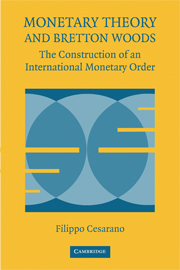Book contents
- Frontmatter
- Contents
- Preface
- Acknowledgments
- 1 INTRODUCTION
- 2 INTERNATIONAL MONETARY EQUILIBRIUM AND THE PROPERTIES OF THE GOLD STANDARD
- 3 THE INTERNATIONAL MONETARY SYSTEM BETWEEN THE WORLD WARS
- 4 THE MONETARY SYSTEM IN ECONOMIC ANALYSIS: THE CRITIQUE OF THE GOLD STANDARD
- 5 THE GREAT DEPRESSION: OVERTURNING THE STATE OF THE ART
- 6 PROVIDING FOR A NEW MONETARY ORDER
- 7 THE BRETTON WOODS AGREEMENTS
- 8 BRETTON WOODS AND AFTER
- References
- Author Index
- Subject Index
1 - INTRODUCTION
Published online by Cambridge University Press: 18 December 2009
- Frontmatter
- Contents
- Preface
- Acknowledgments
- 1 INTRODUCTION
- 2 INTERNATIONAL MONETARY EQUILIBRIUM AND THE PROPERTIES OF THE GOLD STANDARD
- 3 THE INTERNATIONAL MONETARY SYSTEM BETWEEN THE WORLD WARS
- 4 THE MONETARY SYSTEM IN ECONOMIC ANALYSIS: THE CRITIQUE OF THE GOLD STANDARD
- 5 THE GREAT DEPRESSION: OVERTURNING THE STATE OF THE ART
- 6 PROVIDING FOR A NEW MONETARY ORDER
- 7 THE BRETTON WOODS AGREEMENTS
- 8 BRETTON WOODS AND AFTER
- References
- Author Index
- Subject Index
Summary
Over the course of the twentieth century, the monetary system underwent an epochal change. Money's link to a commodity was severed, eliminating the basic feature of the system since the beginning of coinage and producing a break in the evolution of monetary institutions. This transformation was the product of a gradual process extending from World War I to the suspension of dollar convertibility on 15 August 1971, an act that merely gave official recognition to a preexisting state of affairs. The transition from the commodity standard to fiat money was driven by the interplay of the extreme shocks of the interwar period and advances in monetary theory, which were instrumental in designing the new monetary arrangements. The study of the Bretton Woods agreements, then, is best viewed in this context, in which economic analysis acquires a central role. Looking at the Bretton Woods architecture from the perspective of the history of economics thus serves not only to account for the reconstruction of international monetary relations and the key aspects of the reform, but also to shed light on the rise of fiat money.
THE BRETTON WOODS ENIGMA
During the quarter-century in which the Bretton Woods system governed monetary relations, the world economy experienced rapid and relatively stable growth, especially after the leading European currencies restored convertibility on 27 December 1958 (Bordo 1993, 12–27). This date divides the life of the system into two equal subperiods.
- Type
- Chapter
- Information
- Monetary Theory and Bretton WoodsThe Construction of an International Monetary Order, pp. 1 - 20Publisher: Cambridge University PressPrint publication year: 2006



